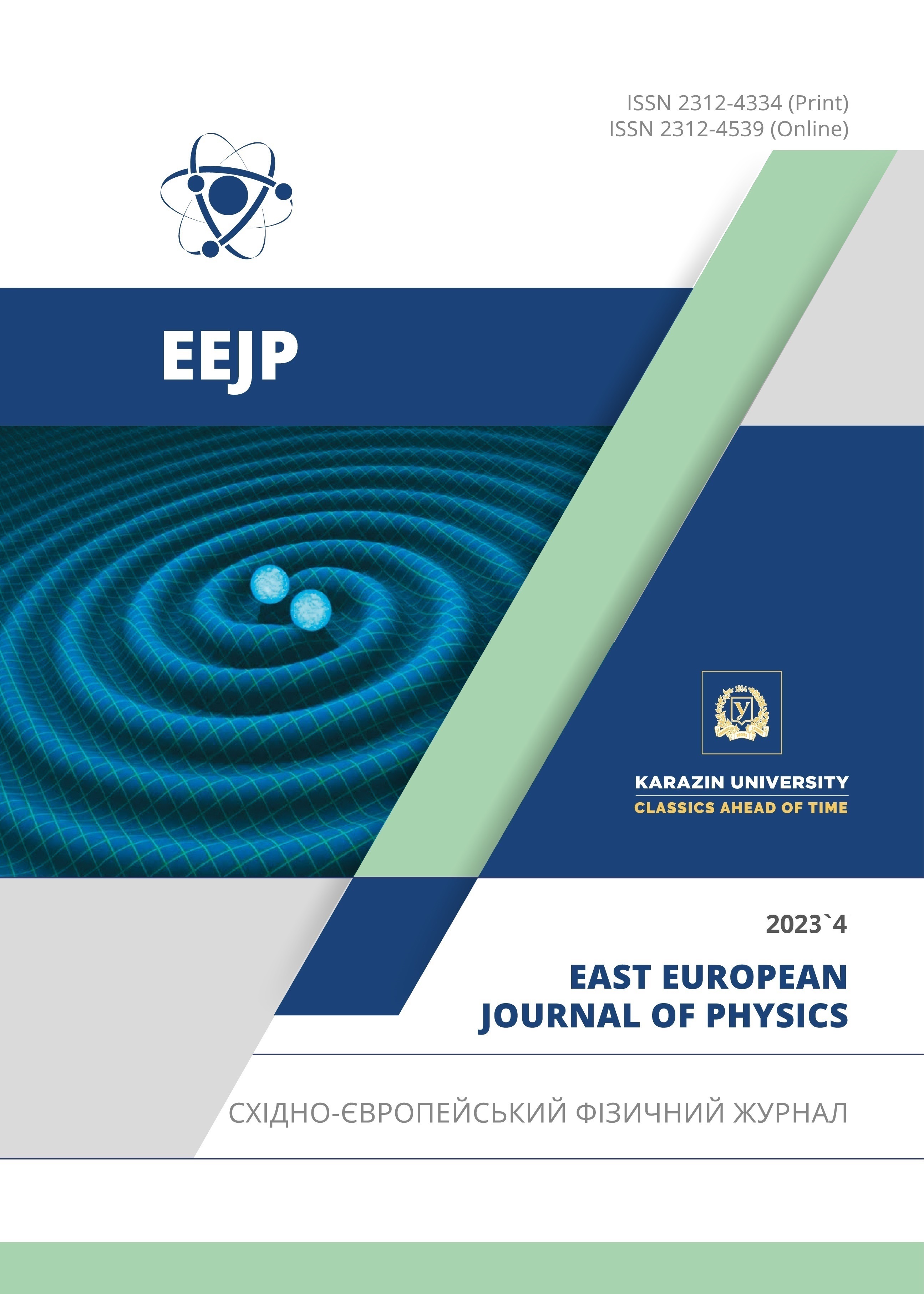Enhancing the Perfection of a Silicon Crystal Doped with Nickel and Zinc Impurities
Abstract
This research paper presents the findings of an investigation into the interaction between zinc (Zn) and nickel (Ni) impurity atoms within a silicon (Si) matrix, which were doped sequentially in various combinations. The characterization techniques employed for this study encompass X-ray diffraction and IR-Fourier spectrometry. It is noteworthy that the degree of crystallinity exhibited by the silicon lattice, subject to the introduction of Zn and Ni impurities, is contingent upon the methodology employed for impurity incorporation. The results of this study reveal a distinctive trend in the optical properties of these doped silicon samples. Specifically, upon the introduction of Zn atoms into silicon that was pre-doped with Ni (Si<Ni, Zn>), there is a concomitant reduction in the concentration of optically active oxygen atoms. Remarkably, this alteration in the dopant composition leads to a marked enhancement in the transparency of the silicon crystal. In stark contrast, when the doping sequence is reversed (Si<Ni, Zn> Ni>), an opposing effect is observed, resulting in a diminishment of crystal transparency. These findings underscore the intricate interplay between the introduced impurity atoms, the dopant sequence, and their collective impact on the optical properties of the silicon matrix. Such insights contribute to our comprehension of the nuanced behavior of doped silicon and have implications for applications requiring tailored optical characteristics in semiconductor materials.
Downloads
References
N.A. Sobolev, “Defect engineering in the implantation technology of silicon light-emitting structures with dislocation luminescence,” Physics and Technology of Semiconductors, 44(1), 3-25 (2010). (in Russian)
B. Al-Aderah, A. Obeidat, and J. Talla, “Influence of transition metal defects on electronic and magnetic properties of bulk silicon: Ab-initio simulation,” Materials Today Communications, 105415 (2023). https://doi.org/10.1016/j.mtcomm.2023.105415
F. Rortais, C. Vergnaud, C. Ducruet, C. Beigné, A. Marty, J.-P. Attané, J. Widiez, et al., “Electrical spin injection in silicon and the role of defects,” Physical Review B, 94(17), 174426 (2016). https://doi.org/10.1103/PhysRevB.94.174426
V.A. Pilipenko, V.A. Gorushko, A.N. Petlitskiy, V.V. Ponaryadov, A.S. Turtsevich, and S.V. Shvedov, “Methods and mechanisms of gettering silicon structures in the production of integrated circuits,” Technology and design in electronic equipment, 2-3, 43-57 (2013). http://nbuv.gov.ua/UJRN/TKEA_2013_2-3_9. (in Russian)
Y. Yoshida, and G. Langouche, editors, Defects and impurities in silicon materials (Springer, Berlin, 2015).
R.C. Newman, “Oxygen Carbon Nitrogen and Hydrogen in Silicon,” in: Proceedings of the Second Symposium on Defects in Silicon: Defects in Silicon II, edited by W.M. Bullis, U. Gösele, and F. Shimura, vol. 91-1, (Electrochemical Society, Pennington, NJ, 1991), pp. 271-285.
S.Z. Zainabidinov, and A.O. Kurbanov, “Atomic clusters of nickel impurity and their influence on the recombination properties of silicon,” Vestnik MGTU im. N.E. Bauman. Ser. Natural sciences, 2, 81–93 (2019). (In Russian)
H.C. Sio, et al. “Fluorine passivation of defects and interfaces in crystalline silicon,” ACS Applied Materials & Interfaces, 13(27), 32503-32509 (2021). https://doi.org/10.1021/acsami.1c07221
E.B. Yakimov, “Metal Impurities and Gettering in Crystalline Silicon,” in: Handbook of Photovoltaic Silicon, edited by D. Yang, (Springer, Berlin, Heidelberg, 2019). https://doi.org/10.1007/978-3-662-56472-1_23
S. Binetti, S. Pizzini, E. Leoni, R. Somaschini, A. Castaldini, and A. Cavallini, “Optical properties of oxygen precipitates and dislocations in silicon,” Journal of applied physics, 92(5), 2437 2445 (2002). https://doi.org/10.1063/1.1497450
F.E. Rougieux, H.T. Nguyen, D.H. Macdonald, B. Mitchell, and R. Falster, “Growth of oxygen precipitates and dislocations in Czochralski silicon,” IEEE Journal of photovoltaics, 7(3). 735-740 (2017). https://doi.org/10.1109/JPHOTOV.2017.2678840
S.S. Nasriddinov, and D.M. Esbergenov, “Kinetics of formation of complex defects in silicon doped with zinc and nickel,” European Science Review, 1-2, 40-45 (2022). https://doi.org/10.29013/ESR-22-1.2-40-45
Zh.Zh. Khamdamov, and D.M. Esbergenov, “Study of the gettering property of Ni impurity in silicon doped with Zn impurity,” in: Modern trends in the development of semiconductor physics: achievements, problems and prospects" II international scientific conference, (Tashkent, 2022). pp. 51-52. (in Russian)
D. Bouhafs, N. Khelifati, Y. Kouhlane, and R.S. Kaddour, “Activation of electrical defects under Rapid Thermal Annealing in Cz-silicon for solar cells application,” Mater. Res. Express, 6, 055907 (2019). https://doi.org/10.1088/2053-1591/aadcc8
S.N. Dobryakov, B.V. Kornilov, and V.V. Privezentsev, Russ. Microelectron. 36, pp. 203 2007. (in Russian)
V. Privezentsev, “Defects in zinc doped silicon studied on base of X-ray diffuse scattering analysis,” Phys. Status Solidi C, 6(8), 1897–1900 (2009). https://doi.org/10.1002/pssc.200881472
S.Z. Zainabiddinov, and Kh.S. Daliev, Defect formation in silicon, (Tashkent State University, 1993). (in Russian)
L. Scheffler, V.l. Kolkovsky, and J. Weber, AIP Conf. Proc. 1583, 85-89 (2014). https://doi.org/10.1063/1.4865610
S.S. Nasriddinov, and D.M. Esbergenov, “A Study of Complex Defect Formation in Silicon Doped with Nickel,” Russian Physics Journal, 65(9), 1559–1563 (2023). https://doi.org/10.1007/s11182-023-02801-x
K. Matsukawa, K. Shirai, H. Yamaguchi, and H. Katayama-Yoshida, “Diffusion of transition-metal impurities in silicon,” Physica B: Condensed Matter, 401-402, 151-154 (2007). https://doi.org/10.1016/j.physb.2007.08.134
A.S. Vorokh, “Scherrer formula: estimation of error in determining small nanoparticle size,” Nanosystems: physics, chemistry, mathematics, 9(3), 364-369 (2018).
Copyright (c) 2023 Daryabay M. Esbergenov, Elmira M. Naurzalieva, Sabirbay A. Tursinbaev

This work is licensed under a Creative Commons Attribution 4.0 International License.
Authors who publish with this journal agree to the following terms:
- Authors retain copyright and grant the journal right of first publication with the work simultaneously licensed under a Creative Commons Attribution License that allows others to share the work with an acknowledgment of the work's authorship and initial publication in this journal.
- Authors are able to enter into separate, additional contractual arrangements for the non-exclusive distribution of the journal's published version of the work (e.g., post it to an institutional repository or publish it in a book), with an acknowledgment of its initial publication in this journal.
- Authors are permitted and encouraged to post their work online (e.g., in institutional repositories or on their website) prior to and during the submission process, as it can lead to productive exchanges, as well as earlier and greater citation of published work (See The Effect of Open Access).








